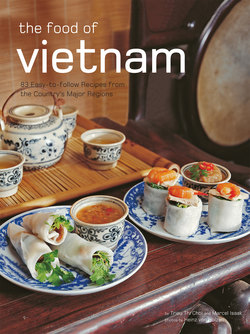Читать книгу Food of Vietnam - Trieu Thi Choi - Страница 9
На сайте Литреса книга снята с продажи.
ОглавлениеCooking Methods
Tips for preparing traditional Vietnamese dishes in a modern kitchen
Vietnamese food, with its wide variety of textures and tastes, is surprisingly easy to cook. An entire meal can easily be prepared in a single wok or a saute pan. While preparation has traditionally been complex and time-consuming, modern conveniences such as the food processor make the work faster and easier.
The adage "the fresher the ingredients, the better the food", is especially true of Vietnamese cooking. The various herbs and lettuces are almost always served raw. and salads are never overdressed, so that the full flavors are present. Vegetables and fish in particular, which make up a large part of the Vietnamese diet, are gently cooked and lightly seasoned, allowing the true flavors of the food to come through.
In addition to the ubiquitous and essential fish sauce or nuoc mam (now available almost everywhere), there are several key ingredients which appear in many of the recipes that require considerable preparation Ingredients such as garlic, shallots, chili, lemongrass, roasted peanuts and ginger, that have traditionally been prepared with a mortar and pestle, can be easily managed with a food processor or a blender However, slicing is more effectively achieved with a sharp knife.
Asian shallots are deep-fried and used as a garnish. Alternatively, French shallots can be sliced very thinly, sprinkled lightly with salt, then gently pressed with a dry towel to dehydrate before frying (the key to getting them crispy is to remove as much moisture as possible).
MSG (monosodium glutamate) is prevalent in Vietnamese food. However, due to health concerns, we have chosen to omit it from all of the recipes, which may easily be done without affecting the integrity of the dishes. Nuoc mam. salt, garlic, pepper, sugar and fried shallots—seasonings used in almost every Vietnamese dish—will compensate for its absence.
When preparing salads, make sure that the lettuce is fresh, cleaned and dried (use a salad spinner). Dress the salad shortly before serving, and be careful not to use too much dressing.
Dried rice paper wrappers used to wrap a variety of rolls, can now be purchased in most Asian food markets. To prepare fresh rice flour wrappers (for transparent rolls), most modern cooks will have to improvise by stretching a piece of fine cloth taut over a pot of steaming water. The rice mix (rice flour, water and salt) is spooned over the surface with a large ladle and smoothed into a round pancake. After covering for a few minutes to steam through, it can be lifted up at the edges with a soft-edged utensil, removed from the cloth, and set aside to be later stuffed, rolled and sliced.
To prepare dried rice noodles, use a large stock pot. Fill to a few inches from the top with water, and bring to a boil. Just before the other ingredients are ready, the noodles are placed in a large sieve, submerged in the boiling water until soft, and then added to the recipe.
In general, once the ingredients have been prepared, they should be arranged in bowls or on a large platter, in the order they are called for in the recipe. Then, as you begin cooking, just follow the recipe and the row of prearranged ingredients.
The cooking methods most commonly used in Vietnamese kitchens are stir-frying, deep-frying and grilling. Stir-fry recipes are cooked in a wok, in either oil or pork fat over a very hot flame, for a short period of time Sautéing in a large skillet is an alternative method, although not nearly as easy. For those cooks wishing to avoid the use of pork fat (which is difficult to replace), try experimenting with other types of oil. To stir-fry, add the oil to a preheated pan, and follow shortly after with the ingredients that are quickly seared. Cooking generally takes only a few minutes, so that the food does not absorb too much of the oil. A traditional curved spatula or long chopsticks are best for handling the hot food.
To deep-fry. you can use the same wok. or a very deep saucepan since a considerable amount of oil is required (peanut oil is preferred). The optimum temperature for deep frying is 375°F to 400°F (190°C to 200°C). To achieve the best results—crisp, not soggy food—cook in small amounts and maintain a high heat but do not allow the oil to smoke.
Grilling is also an important method of Vietnamese cooking that remains as popular and as practical as ever. Using a barbecue is one of the easiest and most effective cooking methods, since grilling over an open flame imparts very distinct and essential flavors that many of the recipes depend upon, although good results can also be achieved using a gas or electric broiler, or toaster oven.
Most of the cooking is done over the open hearth in the traditional Vietnamese kitchen.
